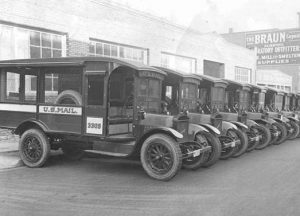Every truck drove at the mercy of the road. The bumps lifted passengers and packages into the air like kids sitting at the back of a modern school bus. The need for a high-quality suspension in a mail truck did not exist.

Every truck drove at the mercy of the road. The bumps lifted passengers and packages into the air like kids sitting at the back of a modern school bus. High-quality suspension in a mail truck did not exist. Automobiles in the 1930s increased industry and travel times even without modern amenities and standards. Thin wheels supported clunky bodies. The flat windshields worked well enough for the low speeds of the simple vehicles. Wire windows of the appropriately large trunk made it seem that the post office feared that letters and boxes would sprout wings and fly away if given the chance. The steering and gear shift mechanisms required more experience than most people had; and the leather cushions that covered the passenger and driver’s combined sitting bench provided more support than comfort. My great grandmother used to endure those seats, wheels, bumps, and windows as she traveled between Iowa and Nebraska visiting her family on weekends.
Clara Loecker married her husband Roy Troutman in 1936 and took his name soon after. Her parents lived in her home town in Nebraska, only a short drive from her new residence in Sioux City, Iowa. But, she never learned how to drive, let alone own a car herself. So, on warm and cold Saturday mornings alike, she walked to the post office. Once there, she waited in the parking lot filled with mail trucks. When the driver heading across the Iowa border and into Nebraska came out to get in his truck, she joined him. She entered the passenger side door and gave the postal worker a dose of welcomed company as he drove the dozens of miles out to her hometown. Once there, she would leave him along his route and spend the day with her family. After the postman finished his route, Clara would find him making his way through her town again and hitch a ride back to Sioux City.
The 1930s postal service lacked the funding and modern standard of the efficient and practiced form of modern mail delivery. Still, the mail had to be delivered. Americans already counted on consistency and convenience and the Post Office Department managed all they could. The trucks were often of different types rather than the uniform modern postal services display. According to a museum’s website “The 4,000 trucks owned by the Department consisted of 43 different types of trucks by 23 different manufacturers” (Smithsonian). This hodgepodge of vehicles reflected the infancy of the automotive industry in America at the time. Trucks often broke down from over usage and lower endurance compared to modern standards. So, each office had to work through the different models and manufacturers to repair the trucks on their own. The work challenged mechanics to improvise and make repairs without the correct parts. These shoddy repairs grew even worse with the arrival of World War II because of the draft and the loss of most of the trained mechanics to the military.
Although my Great Grandmother, Clara Troutman, and her family left Sioux city before the United States entered WWII, the postal truck she rode in likely broke down and required better repairs while she still hitched rides on it. The Post Office managed to survive the war by following a national policy of endurance. Each office worked its trucks beyond their natural car life. Larry Clark who was a Post Office Department Driver said “’Due to [World War II] we literally drove the trucks until the fenders fell, or rusted, off.”’ (Smithsonian). But, the innovation that embodied even the early automotive industry allowed for an improved postal system and for my great grandmother’s visits to her family.
When I talk to my grandmother about her mom, the Great Depression, and World War II, I marvel at how industrious and determined people can be. My grandmother tells me that her mother would have walked to Nebraska if not for the mail truck; but I think the same truck that powered through the 1930s and kept the postal service consistent, also helped my great grandmother maintain a strong relationship with her family. And as I drive back home or to visit a relative, I am ever thankful for the vehicle I drive and its harder working ancestors.
Works Referenced
Smithsonian. On the Road: 1921-1940. https://postalmuseum.si.edu/exhibits/current/on-the-road/1921-1940s.html. March 4, 2019.
Humphrey, Marie. Personal Interview. March 5, 2019